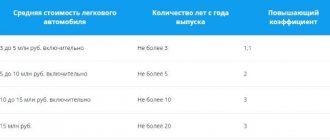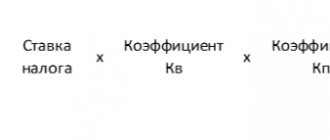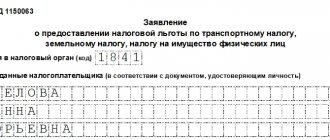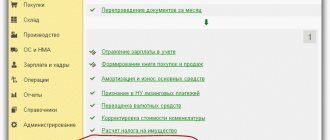How to take into account the “Platonic” fee and transport tax (advance payments) in tax expenses? How to reflect the fee for "Platon" on the accounting accounts? What documents can be used to confirm the deduction of transport tax on the “Platonov” fee?
At the end of 2016, companies that own trucks weighing more than 12 tons were given the opportunity to reduce the amount of transport tax by the amount of the accrued fee (“Platonovsky” fee) to compensate for the damage caused to public roads of federal significance by such vehicles (Article 361.1 of the Tax Code RF, clause 2 of article 362 of the Tax Code of the Russian Federation).
Thus, a transport tax benefit (deduction) is provided to transport tax taxpayers in connection with their payment of compensation for damages in respect of vehicles with a permissible maximum weight of over 12 tons.
OUTSOURCING LEGAL fees reduce the amount of transport tax only for a specific truck weighing more than 12 tons, and not the total amount of accrued transport tax (Letter of the Ministry of Finance of the Russian Federation dated January 13, 2017 No. 03-05-05-04/739).
Deductions for the “Platonic” fee are provided for tax periods 2016 - 2022.
Accounting for transport tax and “Platonov” fee as expenses
The amount of the advance payment made to the operator of the state toll collection system LLC RT-Invest Transport Systems (hereinafter referred to as LLC RTITS) is not an expense and, accordingly, is not reflected in tax accounting (clause 14 of article 270 of the Tax Code of the Russian Federation ).
“Profitable” expenses recognize the difference between the “Platonovsky” fee and the amount of transport tax calculated for the tax (reporting) period in relation to heavy trucks - vehicles with a permissible maximum weight of over 12 tons (clause 48.21 of Article 270 of the Tax Code of the Russian Federation, Letter of the Ministry of Finance of the Russian Federation dated November 21, 2016 No. 03-05-05-04/68317).
PROPERTY “ENERGY EFFICIENT” BENEFITS
Important!
That is, the tax expenses will not include the entire “Platonov” payment in its entirety, but in part of the excess of the amount of transport tax calculated for the heavy cargo for which it was paid (clause 48.21 of article 270 of the Tax Code of the Russian Federation - for companies on the OSN, clause 37 Clause 1 of Article 346.16 of the Tax Code of the Russian Federation - for “simplers”, Clause 45 of Clause 2 of Article 346.5 of the Tax Code of the Russian Federation - for payers of the Unified Agricultural Tax).
What is transport tax
Transport tax is a mandatory tax payment for most owners of registered vehicles, which is levied in accordance with Chapter 28 of the Tax Code (TC). It is paid annually by both individuals and legal entities.
Only owners are exempt from the fee:
- agricultural machinery;
- cars equipped for disabled people;
- Vehicles used in cargo and passenger transportation;
- some other types of equipment specified in Art. 358 NK.
TN is considered a regional fee and remains in the budget of the constituent entities of the Federation, which have the right to independently establish benefits for it, the procedure and terms of payment, etc. TN is paid by individuals once a year, by companies - in the form of quarterly advance payments. In case of violation of the terms and procedure for its payment, taxpayers are assessed a penalty and a fine is imposed, and the arrears can be recovered through the court.
FOR EXAMPLE
The advance payment for transport tax was 120 rubles, and the “Platonov” fee was 100 rubles. In this case, the company, based on the results of the first quarter, half of the year and 9 months, will not take into account the difference in terms of the excess of the transport tax over the “Platonov” fee. And only at the end of the year he will include 20 rubles in tax expenses.
As a general rule, one company can reduce transport tax by the amount of the “Platonov” fee. For example, if vehicles were leased, and heavy trucks were registered to the lessor, then the transport tax cannot be reduced by the “Platonic” fee paid by the lessee (Letter of the Ministry of Finance of the Russian Federation dated July 18, 2016 No. 03-05-04-04/41940 ).
That is, in this situation (heavy trucks are registered to the lessor), and not to the lessee, the lessor has no right to reduce the transport tax by the amount of the “Platonic” fee for the heavy truck.
In “profitable” expenses, you can only take into account the amount of transport tax actually paid (clause 1, clause 1, article 264 of the Tax Code of the Russian Federation, clause 48.21, article 270 of the Tax Code of the Russian Federation, clause 2, article 362 of the Tax Code of the Russian Federation). This means that it is impossible to simultaneously take into account in tax expenses both the amount of accrued transport tax and the deduction for the “Platonic” fee.
CHECKING THE CONTRACTOR
Important!
Thus, the “Platonic” fee reduces profits only to the extent of excess transport tax, and not in full.
If the vehicle is leased, the owner of the vehicle will charge and recognize the transport tax in full, and the lessee will charge and pay the “Platonic” fee and take it into account as part of other expenses.
Plato system and transport tax, how much to pay to whom | Russian lawyer
It is possible that if a contract of agency had been drawn up in accordance with Article 971 of the Tax Code of the Russian Federation, then if there was a document stating that my wife compensated me for the expenses I incurred, the tax authority would have fewer doubts about the legality of applying the transport tax benefit?
After this, you must submit an application to the Information Support Center. All data will be verified, after which a contract is concluded with the user, and he gains access to the system.
How to take into account the “Platonic” fee and transport tax (advance payments) in tax expenses? How to reflect the fee for "Platon" on the accounting accounts? What documents can be used to confirm the deduction of transport tax on the “Platonov” fee?
The transport tax benefit under the Platon system has been canceled since 2019
The capabilities of this service allow you to monitor what is happening online and manage your profile without wasting time on travel and queues. Applies to all public roads of federal significance. The full cycle of creation and operation of the system is provided by its operator, RTITS.
At the same time, the tax return form for transport tax currently being developed and the procedure for filling it out provide for the implementation of the norms of paragraph 2 of Article 362 and paragraph 2 of Article 363 of the Code.
Thus, this payment is intended to compensate for the costs associated with restoring the proper transport and operational condition of public roads of federal importance, i.e.
has a target orientation and economic basis.
Connection between transport tax and the Platon system
Not entirely sure about this scheme. I am afraid that the tax authorities in this case will take a formal approach and take into account the actual payer. But you can try...
Owners of trucks weighing more than 12 tons can reduce the amount of transport tax by the amount of the accrued Platon fee to compensate for damage caused to public roads of federal significance.
Currently, the size of payments under the Platon system does not matter. That is, the amount of deposited funds is not taken into account when calculating tax. All payers will be required to pay transport tax in full. This information is explained in the letter of the Federal Tax Service dated March 22, 2022 No. BS-4-21/
According to paragraph 2 of Art. 362 of the Tax Code of the Russian Federation, the amount of tax calculated at the end of the tax period by taxpayer organizations in relation to each vehicle registered in the Platon system is reduced by the amount of payment paid in respect of such a vehicle in a given tax period.
A special service allows you to make payments online, saving time. The system was introduced in 2015 and had a certain set of benefits for legal entities.
If the amount of the fee paid in 2016 to Platon exceeds or is equal to the calculated amount of transport tax for 2016 in relation to a specific vehicle, then the amount of the advance payment paid for the first quarter of 2016 will be considered an overpaid amount of tax, subject to offset (refund) after submitting your tax return.
The owner of a heavy truck, who paid the transport tax for 2016, expressed a desire to reduce it by the amount of payment to the Platon system for 2017. He will not be able to do this, because...
the tax period does not coincide with the year of payment into the system.
The Platon toll collection system was created and is used to ensure compliance with the procedure for collecting tolls to compensate for damage that was caused to public roads of federal significance.
Transport tax. System "Platon": video
At the end of 2016, companies that own trucks weighing more than 12 tons were given the opportunity to reduce the amount of transport tax by the amount of the accrued fee (“Platonovsky” fee) to compensate for the damage caused to public roads of federal significance by such vehicles (Article 361.1 of the Tax Code RF, clause 2 of article 362 of the Tax Code of the Russian Federation).
Before moving on to considering the situation, let us schematically recall what innovations we are talking about (the procedure for applying the tax deduction for transport tax and accounting for the fee as part of taxable expenses depends on the amount of the fee paid in relation to the calculated amount of transport tax (advance payment) for specific heavy-duty vehicle). The toll collection system acquired the name “Plato”. As conceived by its developers, this is a derivative of the phrase “payment per ton”. Let’s consider the accounting and tax accounting of transactions related to payments to the Platon system.
Reducing transport tax
The procedure for collecting the “Platonov” fee to compensate for damage caused to public roads of federal significance by vehicles with a permissible maximum weight of over 12 tons is established by the Rules approved by Decree of the Government of the Russian Federation of June 14, 2013 No. 504 (hereinafter referred to as - Rules).
Both departments believe that if, in relation to vehicles with a permissible maximum weight of over 12 tons, registered to the owner of the vehicle, a fee for compensation for damage is paid by another person, then the specified owner of the vehicle does not have the right to reduce the transport tax by the amount of the fee paid by another person for damages.
The Platon system was introduced in the Russian Federation in 2015. The reason for the adoption of this innovation was the calculation of damage to federal highways caused by heavy vehicles (weighing more than 12 tons). It has been established that 56% of damage to federal highways is caused by heavy trucks.
To register on the resource you will need to prepare:
- certificate of registration as a company or individual entrepreneur
- individual tax payer number
- vehicle registration certificate.
Does Platon exempt from advance payments for technical tax?
Thus, the car owner is obliged to pay transport tax in an amount reduced by the amount of payment to the Platon system.
If the amount of calculated transport tax for 2016 exceeds the amount of payment paid in respect of such a vehicle in a given tax period, then the advance payment paid for the first quarter of 2016 is subject to offset against future payments.
Advance payments for transport tax, starting from January 1, 2016, in respect of a vehicle with a permissible maximum weight of over 12 tons, registered in the register, are not paid (paragraph 2, paragraph 2, article 363 of the Tax Code of the Russian Federation, Letter of the Federal Tax Service of the Russian Federation dated November 22. 2016 No. BS-4-21/22163).
This is compensation for the destruction of highways by trucks. The funds received go to the Federal Budget of the Russian Federation, then they are used to ensure the maintenance of highways, finance construction and repair work, and improve road and transport infrastructure. The system is designed to improve the transport and operational condition of federal roads.
Thus, a transport tax benefit (deduction) is provided to transport tax taxpayers in connection with their payment of compensation for damages in respect of vehicles with a permissible maximum weight of over 12 tons.
This law came into force on July 3, 2016, when obligations for advance payments for transport tax and corporate income tax for the first quarter of 2022 had already been determined. This raises the question of how to take into account changes introduced retroactively.
The funds received go to the Federal Budget of the Russian Federation, then they are used to ensure the maintenance of highways, finance construction and repair work, and improve road and transport infrastructure. Drivers of heavy-duty vehicles are already familiar with the Plato system firsthand. How the Plato system and transport tax are interconnected will be discussed in this article.
ATTENTION! The procedure for payments of this nature is regulated by Federal Law No. 257-FZ of November 8, 2007 “On highways and road activities in the Russian Federation and on amendments to certain legislative acts of the Russian Federation.”
More than 50% of the total damage to federal roads is caused by heavy vehicles weighing more than 12 tons: the passage of one heavy truck is compared to the movement of 25,000 cars.
A blog is your new tool to talk about yourself. Publish any content about your company. Vasily, well, everyone makes mistakes, even employees of the Federal Tax Service. Now you can appeal the denial of benefits if you think you are right.
Reflection of transport tax and Platon fee in accounting
The procedure for reflecting in accounting transactions for the calculation and transfer of “Platonovsky” fares with the subsequent deduction of transport tax in relation to heavy trucks is recommended by financiers in the Letter of the Ministry of Finance of the Russian Federation dated December 28, 2016 No. 07-04-09/78875.
The amount of the advance payment made to the operator of the state toll collection system, RTITS LLC, is not an expense and, accordingly, is not reflected in the cost accounts, but is taken into account as part of accounts receivable (clause 3, clause 16 of the Accounting Regulations PBU 10/ 99 “Expenses of the organization”, approved by Order of the Ministry of Finance of the Russian Federation dated May 6, 1999 No. 33n).
Thus, the transferred advance payment of funds to the Platon operator is reflected in the debit of account 76 “Settlements with various debtors and creditors.”
In accordance with clause 16 of PBU 10/99, expenses are recognized as a decrease in economic benefits as a result of the disposal of assets (cash, other property) and (or) the emergence of liabilities, leading to a decrease in the capital of this organization, with the exception of a decrease in contributions by decision of participants (owners of property ). Taking this into account, the amount of the “Platonic” fee payable by an economic entity is recognized as an expense in accounting.
Based on this and the Instructions for the application of the Chart of Accounts for accounting of financial and economic activities of organizations, approved. By Order of the Ministry of Finance of the Russian Federation dated October 31, 2000 No. 94n, the accrued amount of the “Platonovsky” fee is reflected in the debit of cost accounting accounts in correspondence with the account for accounting settlements with the budget.
This means that the full amount of the fare accrued by the operator RTITS LLC is included in expenses for ordinary activities during the period when the operator charges the fare (clause 18 of PBU 10/99).
When reflecting in the accounting records the transport tax due for payment to the budget at the end of the tax period, the amount of such tax minus the amount of the “Platonov” fee actually paid in a given tax period is credited to the account for accounting settlements with the budget.
INTRODUCTION OF DOWNTIME FOR REASONS NOT DEPENDING ON THE EMPLOYER
Important!
Advance payments for transport tax for heavy loads for which the “Platonov” fee has been paid are not reflected in accounting.
That is, in relation to heavy trucks for which the “Platonov” fee is paid, the transport tax is reflected in the accounting accounts at the end of the year and in terms of the excess of the transport tax accrued at the end of the calendar year over the toll accrued during this period.
Transport tax for Platon trucks
The Platon system is a transport tax instrument that is imposed on all trucks weighing more than 12 tons. For more information about what it is, why it is needed and how it functions, read the article.
Description of the Plato system
The first thing worth noting is that mandatory payments under the Platon system are not a tax from a legal point of view. The Constitutional Court of the Russian Federation, in resolution No. 14-P, established that these payments constitute a public individual payment. This is important to consider for two reasons:
- the presence of these payments does not eliminate the existence of the tax;
- regulations and regulation are different from those inherent in taxes.
The main task of the system is to become a tool that will allow you to pay the toll with an accuracy of up to a kilometer.
Such meticulous accuracy is ensured by means of a route map or on-board device. They represent a document previously created and submitted for registration along the intended route by the owner of the vehicle, and an on-board device BU 1201 with built-in GSM/GPRS/GLONASS for navigation.
The presence of an installed system in the vehicle is checked either “on site” using stationary frames, or remotely using pre-installed equipment.
One thing is worth noting about the prerequisites for the creation of the system: the development was due to the fact that standard taxes were not enough to maintain the roads in an acceptable condition. The federal and regional taxes paid by drivers previously, and in rare cases now, did not cope with their task. As a result, the budget “holes” had to be “filled” with something.
Registration procedure for legal entities and individual entrepreneurs
Registration in the database is carried out on the official website, where you need to enter information about the registered person depending on his legal status. Data that is common to all includes:
- the registration address of the subject and the actual place of the activity;
- bank account or card details;
- scan of the document confirming the fact of registration with the tax office;
- information about the car: serial number of the sign, make, model, VIN code, weight of the vehicle according to its passport, etc.
After the final verification of documents, the account is registered.
How to pay advance payments and use postpayment
Before moving on to the methods, let's briefly consider the payment scheme: advance payments are available only when applying for a route card, and postpayment when using an on-board device.
So, now regarding advance payment methods:
- Personal account “Plato. This is the main and simplest method of making an advance payment. The user must provide all identifying information and enter card details. After this, you only need to top up your account with the required amount in accordance with the terms of the system or repay what has already been issued.
- Online payment via bank. Each bank has payment from the “Personal Account”. Therefore, if the bank supports the Platon payment system, you only need to log into your bank account, go to the “Payments” section, enter the “Platon” details in the appropriate field and pay.
- Bank transfer. It is an analogue of an online payment, but through a bank branch. Be sure to have your account details in the system with you - payment is made either through the terminal or with the help of a bank employee. The transaction period is 5 business days.
- Payment systems and terminals. Payment for Platon through payment systems is made in the same way as through a bank’s personal account. In the “Payments” section you need to select “Plato” and provide all the details. If you deposit funds through the terminal, you will first need temporary authorization in your account.
In the case of using postpayment, the final cost is determined and the actual payment is made at the end of the trip. Payment is made through your personal account or bank transfer, including online payment.
Payment amount: tariff and reduced cost
The tariff for 2022 is: 1 km - 1.90 rubles. However, it is also worth noting that the legislation provides for a reduction in the amount paid for transport tax. So, there are several scenarios:
- if the amount of funds paid to Platon exceeds the transport tax, it is not subject to payment;
- the subject is obliged to pay the difference if the amount paid to Platon is less than what is implied in the transport tax.
FOR EXAMPLE
The company transferred an advance payment of 50,000 rubles to the operator of the Platon system. According to the report of the operator RTITS LLC, the fare for the first quarter of 2022 amounted to 20,000 rubles.
In the accounting accounts, these transactions will be reflected in the following accounting entries:
| Debit 76 “Settlements with the operator RTITS LLC” | Credit 51 “Current account” | — | 50,000 rub. | An advance payment was transferred to the operator RTITS LLC |
| Debit 20,23,25,26,29,44 | Credit 68 “Calculations with the budget using the Platon fee” | — | 20,000 rub. | Tolls for heavy trucks are taken into account as expenses for ordinary activities |
| Debit 68 “Calculations with the budget using the Platon payment” | Credit 76 “Settlements with the operator LLC RTITS” | — | 20,000 rub. | Payment of tolls for heavy trucks to the budget is reflected |
Note.
Accounting entries are provided for heavy cargo vehicles for which the “Platonov” fee is transferred. For other vehicles, advance payments are still made (if the Law of the subject of the Russian Federation provides for such a procedure), which are reflected quarterly in the accounting accounts (in the last month of the reporting quarter).
It should be noted that the company determines the procedure for accounting for fares independently and enshrines it in its accounting policy (clause 4 and clause 7 of the Accounting Regulations PBU 1/2008 “Accounting Policy of the Organization”, approved by Order of the Ministry of Finance of the Russian Federation dated 06.10.2008 No. 106n).
Therefore, the company may use a different accounting record scheme.
Accounting
Transport tax expenses are reflected in the accounting department in account 68. Transport tax relates to expenses for ordinary activities. The procedure for how it will be reflected in accounting depends on the organization in which the vehicle is used.
Here are the entries that reflect this tax:
- Dt 76 - Ks 51 - advance payment is transferred to the operator;
- Dt 20 - Kt 76 - the fee that was calculated for travel is included in expenses.
If this is provided for by the organization’s accounting policies, then the amount of fees that the operator transfers to the budget may additionally be reflected. This amount is reflected in the subaccounts of account 76.
In what amount will expenses be reflected in tax accounting in the first quarter of 2022?
As already noted, for the purpose of calculating income tax, the “Platonovsky” fee is taken into account as part of other expenses, taking into account the restrictions provided for in clause 48.21 of Article 270 of the Tax Code of the Russian Federation.
Let’s assume that the amount of calculated advance payments for heavy cargo (the amount is determined solely for calculating tax liabilities, but is not reflected in the accounting accounts) amounted to 5,000 rubles.
Then for the first quarter of 2022 the company will take into account 15,000 rubles (20,000 rubles - 5,000 rubles) in tax expenses.
And the company does not include advance payments for transport tax as part of tax expenses, since advance payments are preliminary payments, the payment of which is provided for during the tax period (clause 3 of Article 58 of the Tax Code of the Russian Federation), and therefore take them into account on the basis of clause 1 Article 264 of the Tax Code of the Russian Federation is impossible.
That is, for each last day of the 3rd month of the 1st, 2nd and 3rd quarters, the “Platonic” fee can be taken into account in expenses in a portion exceeding the advance payment for transport tax calculated for the same truck and for the same quarter.
ACCOUNTING SERVICES FOR TRANSPORT AND LOGISTICS COMPANIES
In what cases is it impossible to reduce the amount of tax?
If the taxpayers of the transport tax and the Platon program are not the same persons, then the benefit cannot be applied. This rule also applies to situations where the vehicle is leased.
In this case, it is impossible to take into account the amount of amounts contributed under the Platon program in the form of a deduction specifically for the owner of the vehicle, since the payments were not paid by him.
https://www.youtube.com/watch?v=_j6iiiAUTNU
The Treasury Department believes that this provision is reasonable because the costs are borne by different people and organizations.
Documentary evidence of transport tax deduction
The operator, in relation to each registered heavy load in the register of the toll collection system, maintains a personalized record of the owner (possessor) of the vehicle, containing the following information, updated at least once a day, for each vehicle of the owner (possessor):
- the route traveled by the vehicle;
- planned route;
- time and date of movement of the vehicle on public roads of federal significance in accordance with the route map;
- operations for the vehicle owner to pay a fee to the operator, indicating its amount, as well as the date and time of receipt;
- other operations.
Documentary evidence of the toll fee is the operator's report, which indicates the route of the heavy truck with reference to the time (date) of the start and end of the movement of heavy trucks, and primary accounting documents drawn up by the taxpayer himself, confirming the use of this heavy truck on the corresponding route (Letters of the Ministry of Finance of the Russian Federation dated 11.01. 2016 No. 03-03-RZ/64, dated December 28, 2015 No. 03-03-06/1/76740).
In order to recognize expenses for the purpose of calculating income tax, it is necessary to have documentary evidence of expenses (clause 1 of Article 252 of the Tax Code of the Russian Federation).
TAX BENEFITS FOR SMALL BUSINESSES USING THE EXAMPLE OF MOSCOW
Important!
The deduction when calculating transport tax in relation to heavy goods must be applied based on the amount indicated in the route map or register (for the corresponding calendar year) in relation to this heavy goods. And the use of a deduction when calculating transport tax in the amount of the advance payment paid to the toll collection system on account of planned routes is unlawful (Letter of the Ministry of Finance of the Russian Federation dated January 26, 2017 No. 03-05-05-04/3747).
Thus, the deduction of transport tax on the “Platonov” fee is applied based on the amount of the fee only for the route actually traveled by the heavy load.
How to reduce transport tax on Plato?
Owners of heavy vehicles who pay tolls on free federal highways have every right to offset Plato against the transport tax, thus reducing financial costs.
photo from the website 112.ua
The mathematical calculations are relatively simple. When calculating the transport tax, Plato is taken into account according to the following algorithm:
- Calculation of transport tax (TN) for a large-capacity truck in the usual manner;
- Calculation of the amount payable taking into account funds paid to the operator of the Platon system.
Algorithm for calculating standard TN
So, first you need to calculate TN. It should be taken into account that this type of fees is included in the budget of the constituent entities of the Russian Federation and is regulated by their legislative acts. This means that the parameters necessary for calculations must be looked for in regional regulatory documents, and specifically in the law “On Transport Tax”, which was adopted in this administrative unit.
Please note that the TN is charged at the place of registration of the vehicle. Accordingly, it is necessary to focus on the standards in force where the truck was registered with the traffic police.
The amount of a standard fuel charge for a truck is calculated based on the following parameters:
- Current tax rate;
- Vehicle ownership time;
- Engine power.
The tax rate varies from region to region, and is set differentially depending on engine power. Accordingly, the more horsepower a heavy-duty vehicle has, the higher the applicable rate will be for it.
For example, for trucks from 200 to 250 hp registered in the Kursk region, the current rate is 57 rubles. for every horsepower. The fuel charge due for 2016 from a 220-horsepower heavy-duty truck will be equal to:
220 × 57 = 12,540 rubles
photo from widefon.com
But what if the owner purchased the truck within a year? After all, in this case it is illogical to pay the full amount. Russian legislation provides for such a situation and allows payment only for the months of actual ownership. For example, for the same heavy truck, but purchased on August 21, 2016, payment is due only from August to December - for 5 months.
220 × 57 × 5/12 = 5225 rubles
For the month in which the purchase and sale transaction was carried out, TN tax is charged to both the seller and the buyer. The owner takes into account the month of purchase when crediting Plato to the vehicle tax bill. The same right is granted to the previous owner, regardless of whether the transaction occurred at the beginning or end of the month.
How to include Plato in transport tax?
Due to the fact that this scheme only works for the first year, questions about its correct design are raised quite often. You should get information from Art. 346.16, Art. 264, and Art. 270 Tax Code. The calculation formula is as follows:
The annual amount that should be taken into account in expenses = funds transferred to the Platon operator for the reporting year - the amount of TN due for payment for the same period
photo from the site www.gazeta.ru
Further, cargo carriers paying transport tax and Plato make accounting entries as follows:
- If, as a result of previous calculations, a zero value is obtained, then nothing is recorded as expenses;
- If the calculation results in a negative value, then the expenses to be paid should be taken into account.
Motor carriers often propose the idea of shifting tolls on federal roads to customers. This approach is extremely inappropriate, since the transport company loses the opportunity to apply the “transport tax deduction Plato” formula, and the customer company will not be able to indicate this amount in its expenses, since this is a mandatory payment for the carrier, and not for the customer.
FOR EXAMPLE
RUB 3.73/km, coefficient 0.41
— the distance traveled by vehicles registered in the Toll System Register (km).
For example, 4,975.311 km.
| Balance at the beginning of period (rub.) | Accrued for the period (RUB) | Accrual adjustment (RUB) | Funds credited (RUB) | Refund/transfer of enrollment (RUB) | Balance at the end of the period (RUB) |
| 0 | 7 608,51 | 0 | 50 000,00 | 0 | 42 391,49 |
The amount of the fee to be paid when moving a heavy load along the planned route is indicated in the route map or calculated through a toll collection system based on data received from the on-board unit or a third-party on-board unit in automatic mode.
The calculation looks like this:
3.73 rub./km x 0.41 x 4,975.311 km = 7,608.51 rub.
In this case, the calculation takes into account the amounts for canceled route cards and adjustments made to charges for on-board devices.
Such a report is generated automatically from the state toll collection system “Platon”. A similar document is prepared by the operator of the state toll collection system, RTITS LLC, acting on the basis of the Order of the Government of the Russian Federation of August 29, 2014 No. 1662, the Decree of the Government of the Russian Federation of June 14, 2013 No. 504, of May 18, 2015 No. 474, dated 03.11.2015 No. 1191.
The extract is necessary to track the status of settlements on the “Platonic” fee.
It does not contain information about the dates of movement, numbers of heavy trucks.
To do this, you need to order details of transactions by travel date through the company’s personal account.
Detailed operations by travel date.
Legal meaning of the simplified procedure for collecting fees in the Platon system
With the launch of the Platon system (in November 2015), a wave of criticism and negative comments began regarding the new mandatory payments.
In addition, they tried to fight against the Platon system using legal methods. One of the main complaints about the new fee was that the same object (heavy cargo) is subject to 2 payments simultaneously with approximately the same purpose:
- transport tax (Chapter 28 of the Tax Code of the Russian Federation), one of the main purposes of which is to maintain roads in an acceptable condition;
ATTENTION! From 2022, the procedure for paying transport tax has changed.
Find out how organizations can check and pay transport tax from January 1, 2022 in ConsultantPlus. Get free demo access to K+ and go to the Ready Solution to find out all the details of this procedure.
- toll on federal roads (Resolution of the Government of the Russian Federation dated June 14, 2013 No. 504), funds from the collection of which should also be used for road repairs.
The only difference between these “extortions” was that the transport tax is regional, and payments to Platon are federal. But for ordinary owners of heavy trucks, forced to pay both, in practice such a difference did not matter.
For information about which vehicles are classified as heavy-duty trucks, read the article “Platon System - which vehicles fall under it?”
In this regard, despite the fact that the Constitutional Court of the Russian Federation, in its resolution No. 14-P/2016 dated May 31, 2016, concluded that the fee in the Platon system does not contain any signs of a tax, it was decided to make life easier for owners of heavy trucks. This was done by the law of July 3, 2016 No. 249-FZ, which introduced further adjustments to the Tax Code of the Russian Federation and made it possible to reduce the burden of the transport tax payer through payments to the Platon system.
IMPORTANT! This procedure for calculating transport tax also affected the procedure for attributing its amounts to expenses for the purpose of calculating profit (income) tax. The general meaning of the changes is that the tax base for profit (income) cannot be simultaneously reduced by the amounts offset. In this material we will not dwell on this point.
About the features of accounting for fees in Platon for heavy cargo, read the material “How to reflect fees in the Platon system in accounting - recommendations of the Ministry of Finance.”
This report provides the following data:
Account number, balance, number of heavy loads and then details of transactions by date and heavy load.
| Movement date | GRZ | Type of transaction | Path along the federation routes, km | Enrollment | Write-off |
| 30.12.2016 | E285VA174 | Charging (BC) | 75.129 km | RUB 114.88 | |
| 30.12.2016 | E275MA174 | Charging (BC) | 74.03 km | 115.22 rub. |
At the end of the year, you can confirm your right to deduct transport tax using the report “Information on motor vehicles with a permissible maximum weight of over 12 tons, as well as information on payment of payment for compensation for damage caused to federal highways,” which is generated for each heavy load (Letter of the Federal Tax Service of the Russian Federation dated August 26, 2016 No. BS-4-11/15777).
Questions and answers
- I am an individual entrepreneur and the owner of a heavy truck. Back in February, I sent documents to the Federal Tax Service regarding payment of payments to Platon, but I received a notification about the need to pay transport tax in full. What can be done in this case?
Answer: In this case, you need to contact the Federal Tax Service with an application and documents confirming payment of payments to the Platon system. You will be recalculated. Transport tax for 2022 must be paid by December 1, 2022.
2. I plan to lease a heavy truck, but I cannot figure out the responsibility for paying transport tax and payments to the Platon system. Who should pay for what?
Answer: The owner of a vehicle with a permissible weight of over 12 tons is required to pay transport tax, i.e. the lessor, but to pay a fee to compensate for damage caused to public roads of federal significance, i.e. payments to the Platon system are required by the user of the vehicle, i.e. lessee (in this case, you will be the lessee).
Where can the owner(s) of the vehicle obtain such information?
Information interaction between the owner and operator is carried out through the use of the following service channels:
- user information support centers;
- information resource of the toll collection system, located on the Internet information and telecommunications network (www.platon.ru), and the personal account of the owner (owner) of the vehicle, which ensures that the owner (owner) of the vehicle is provided with information contained in the personalized record of the owner (owner) of the vehicle funds that include a settlement entry(s);
- a user information support center, which is a complex of technical means without personnel, providing, among other things, the possibility of registration in the toll collection system and payment of fees by the owner (possessor) of the vehicle.
Important!
All of the above reports can be generated by the owner of heavy trucks through his personal account on the official Platon website (https://platon.ru) or in a similar mobile application.
Reflection of the “Platonov” fee in the transport tax return
The transport tax declaration, in which the taxpayer can indicate a tax benefit and (or) deduction for a vehicle with a permissible maximum weight of over 12 tons, was approved by Order of the Federal Tax Service of the Russian Federation dated December 5, 2016 No. ММВ-7-21/ [email protected]
Despite the fact that the Order of the Federal Tax Service is in effect starting with the submission of a tax return for 2022, those taxpayers who need to apply the heavy-duty exemption could already report using the new form for 2016 (clause 3 of the Letter of the Federal Tax Service of the Russian Federation dated December 29, 2016. No. PA-4-21/ [email protected] ).
How does the Plato system work?
It performs several main tasks:
- Information processing;
- Collection of necessary information;
- Saving data on the movement of trucks on highways.
Motorists can use this system for free. However, they must register on the system website. You will have to pay 600 rubles every month for the service.
The Platonic program block is installed in the car. Through a mobile connection, he reports the coordinates of the vehicle to a special center. The received data is processed. After this, the driver is issued an invoice for trips on federal highways.
The functioning of the Plato system occurs automatically. If the car turns off the federal highway, the system turns off automatically. All vehicles weighing more than 12 tons are required to join the system. Only those cars that transport people, as well as various company cars, are exempt from taxes.
The tax payment scheme under this system is advance. Those. First, money is deposited, and after that the operator gradually writes off the required amount. Payment is made for each kilometer of travel.








